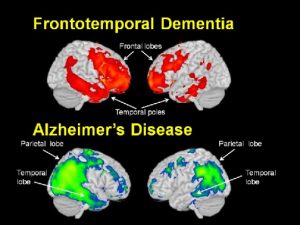Hello Writing Technicians!
Introduction:
Assignment 1.3 asks students to write three different definitions, each varying in the amount of detail provided, for a complex term within our discipline. The objective of this assignment is to understand when to use certain types of definitions based on the purpose of the writing and the audience it is intended for. Therefore, students must create a ‘reading situation’ where the term is being defined to an audience of “non-technical readers”. Using at least three outside references, students must compose a parenthetical definition, sentence definition, and an expanded definition of the term. For the expanded definition, students must use at least four expansion strategies and at least one visual. Lastly, students should include a works cited in MLA style or APA style.
Term: Frontotemporal Dementia
Definition:”https://www.alz.org/alzheimers-dementia/what-is-dementia/types-of-dementia/frontotemporal-dementia”
Reading Situation: Mary McDonald, a patient at the Houston psychology clinic, is discussing her recent test results with her clinical psychologist. After looking at the results from a battery of test, the psychologist believes Mary may have a type of dementia called frontotemporal dementia. Therefore, the psychologist will use the following definitions of frontotemporal dementia to explain a potential cause for her test results.
Parenthetical definition: Frontotemporal dementia (a neurodegenerative brain disorder) is a common cause of early-onset dementia.
Sentence definition: Frontotemporal Dementia is a subtype of dementia characterized by the progressive degeneration of nerve cells in the brain’s frontal or temporal lobes – areas that are commonly associated with personality, behavior, language, and motor function. The loss of nerve cells causes the lobes to shrink in size. As time progresses, the lobes increase the speed at which they shrink causing more severe symptoms.
Expanded definition:
Etymology
The term, frontotemporal dementia can be summarized by its etymology as a patient who is insane in the frontal and temporal areas of the brain. The first part of the term, frontotemporal, is a combination of the words fronto and temporal, meaning concerning the frontal and temporal areas of the skull. The second part of the term, sdementia originated from the Latin term demens, which translates to out of one’s mind.
Operating Principle
Various imaging techniques are used to diagnose frontotemporal dementia. Computed tomography (CT scan) and magnetic resonance imaging (MRI) reveal a decrease in neurons in the frontal and temporal lobes. Functional brain imaging reveals decreased blood flow in the frontal lobe suggesting a reduced function in that region.
Compare and Contrast
Frontotemporal dementia is often misdiagnosed as Alzheimer’s disease due to the significant overlap of initial symptoms. Therefore, it is imperative to distinguish between the two disorders. Symptoms of Frontotemporal dementia usually occur between the ages of 40 and 60, whereas the symptoms of Alzheimer’s disease occur in people over age 65. Unlike Alzheimer’s disease, the first noticeable symptoms of frontotemporal dementia are related to behavioral changes. Behavioral symptoms can occur as Alzheimer’s disease progress; however, they tend to happen in the later stages of the disorder. Lastly, people with frontotemporal dementia tend to have more pronounced speech and language symptoms than people with Alzheimer’s disease.

Figure 1 Differences in brain scans of frontotemporal dementia patients and Alzheimer’s patients. In the figure above, the colored areas represent neuron degeneration. Anatomically, both patients experience dysfunction in the temporal lobe, however, frontotemporal dementia patients experience more dysfunction in the frontal lobe while Alzheimer’s patients experience more dysfunction in the parietal lobe.
Source: https://www.google.ca/url?sa=i&source=images&cd=&ved=2ahUKEwjM94f334TgAhWkwFQKHUGzAEgQjRx6BAgBEAU&url=http%3A%2F%2Falzheimers-review.blogspot.com%2F2015%2F09%2Ffrontotemporal-dementia-ftd-or-picks.html&psig=AOvVaw1QZTm_uHrGc3wUunrlo80j&ust=1548361619172016
Analysis of Parts
The signs and symptoms of this disorder vary from one individual to the next, but clinicians have identified three clusters of symptoms. The first cluster, behavioral changes, include apathy, overeating, lack of judgment and inhibition and repetitive, compulsive behavior. The second cluster, speech and language symptoms, include difficulties with naming objects, losing knowledge of words, and having nonfluent or hesitant speech. The third cluster, movement symptoms, includes: tremors, poor coordination, muscle weakness, and difficulties swallowing.
Sadly, there are no current treatments to slow the progression of the disease, but there are treatments that help alleviate symptoms. Antipsychotic medication and antidepressant medication can both be used to improve behavioral symptoms of frontotemporal dementia. Also, speech therapy can be used to learn alternate strategies for effective communication.
References
1.“Dementia.” Dictionary.com, www.dictionary.com/browse/dementia.
2.“Frontotemporal Dementia.” Is There Really Any Benefit to Multivitamins?, www.hopkinsmedicine.org/healthlibrary/conditions/nervous_system_disorders/frontotemporal_dementia_134,77.
3.“Frontotemporal Dementia.” Alzheimer Society of Canada, alzheimer.ca/en/Home/About-dementia/Dementias/Frontotemporal-Dementia-and-Pick-s-disease.
4.“Frontotemporal Dementia.” Mayo Clinic, Mayo Foundation for Medical Education and Research, 29 Oct. 2016, www.mayoclinic.org/diseases-conditions/frontotemporal-dementia/diagnosis-treatment/drc-20354741.
Leave a Reply